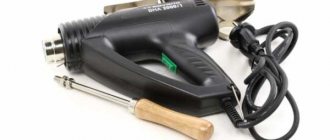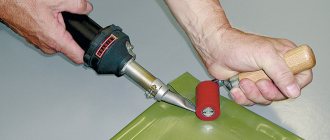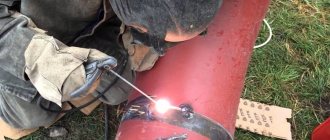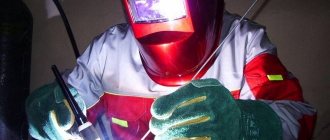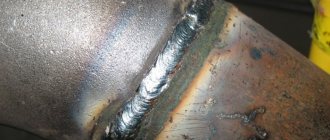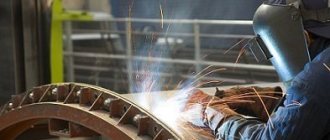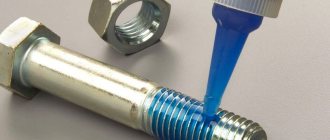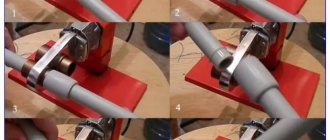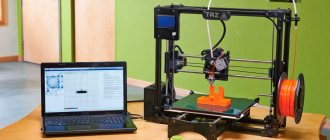Plastic welding is an effective way to lay polypropylene pipes and repair plastic products. A uniform seam is obtained by heating and melting. Special devices are designed for this. Anyone can learn to work with them. When choosing a technology, the advantages and disadvantages of each method are taken into account.
Welding plastic is the most economical technological method.
General information about welding thermoplastics
Connecting plastic parts by heating is a technology that has long been used in industrial settings and home workshops. The use of hot methods is only possible when working with materials belonging to the group of thermoplastics. This is the name for types of polymers that fully retain their characteristics after heating, melting and cooling. This is their difference from thermosets, which are destroyed by heating and final processing.
At high temperatures, such materials burn, while thermoplastics melt.
Security measures
Cold welding for plastic does not contain solvents or other toxic compounds, so the seams after drying are absolutely safe for people.
Carrying out work requires compliance with safety measures:
- Do not allow the mixture to come into contact with exposed skin. Use IZ means.
- Work is carried out in well-ventilated areas with proper ventilation.
- Welding seams should not come into contact with food.
- If the mass gets on the skin or mucous membranes, immediate rinsing with water is required; in severe cases, consult a doctor.
- When working, it is unacceptable to leave the material in a place exposed to direct sunlight.
Types of plastic with weldability characteristics
The joining method is chosen in accordance with the type of polymer and its characteristics.
They are distinguished by high weldability:
- Polyethylene. Products made from such plastic are joined by melting the edges, which are then combined under pressure to prevent deformation.
- Polypropylene. The material is used in the production of pipes, which are connected using a 1500 W electric soldering iron. By increasing the temperature at the junction, the 2 elements are tightly fastened. The properties of the material help to obtain a seam that does not allow moisture to pass through.
- Polyvinyl chloride (PVC). Plastic does not deform when heated. The welded joint is strong and uniform.
Polypropylene is a synthetic thermoplastic non-polar polymer.
The following polymers have medium or low weldability:
- Polystyrene. The polymer is used in the manufacture of dishes, toys, and household items. Parts made from this polymer have rather poor weldability and require careful preparation.
- Polyvinyl chloride. It is not recommended to use hot methods when comparing elements from such a polymer. This is explained by the possibility of edge deformation, which impairs the quality of the seam. Cold methods are more effective.
We recommend reading: Heating temperature of polypropylene when soldering pipes
Hot welding methods and necessary equipment
The following tools are used to connect plastic elements by heating:
- manual units that produce a stream of hot air;
- extruders;
- devices for joining sheet polymers;
- automatic welding units.
A plastic welding hairdryer can be used to join any thermoplastics.
To choose the right thermoplastic welding tool, you need to study the operating principles, advantages and disadvantages of each device.
Handheld hair dryer or gun
Together with such equipment, a consumable material is used - a rod, which is placed between the elements to be connected. After this, the seam is heated with a construction hairdryer. The device resembles a household appliance used for drying and styling hair. The temperature and power of an industrial hair dryer are higher. Thanks to this, the edges of the elements being welded are melted, forming a homogeneous mass. As it hardens, it holds the parts together.
The temperature of the air stream is adjusted automatically or manually. The kit includes attachments that help connect plastic elements end-to-end or overlapping. The nozzle configuration is selected depending on the type of plastic, the thickness of the parts, and the experience of the welder.
Household hair dryers are used to perform routine operations. Industrial options are designed for laying polymer pipelines.
Extruder
The device is similar to a gun, at the end of which there is a nozzle for fixing a filler rod or tube.
An extruder is a machine for continuous processing of polymer raw materials.
The operating principle is based on:
- heating the consumable to a semi-liquid consistency;
- removing mass to the junction of parts;
- solidification of the melt followed by the formation of a seam.
Using an extruder, you can weld elements of any thickness in one pass. The performance of the device is higher than that of a hair dryer. The main disadvantage is the inability to weld products made from different types of plastic. This is due to the difference in melting temperatures. Before starting work, the edges of the parts are cleaned of traces of dirt and grease that can impair the quality of the seam.
We recommend reading: How to solder polypropylene pipes
contact welding
The equipment produces short-term heat pulses applied in combination with pressure. The devices are used at production sites where welded polymer sheets are produced.
Instructions for use
The durability and quality of bonding depends on proper preparation of surfaces. Instructions for use are written step-by-step by the manufacturer on the box or tube. To avoid skin damage, it is recommended to wear gloves. The execution sequence affects the quality of further work of the glued element.
Before applying cold welding, you need to rub the area of the damaged surface with fine sandpaper or a file. Degrease the area with solvent or acetone. Failure to do this procedure may cause a rupture.
Quickly apply a small layer of glue. The remaining composition cannot be reused, so first calculate the required amount. After application, you will need a tourniquet or a press for strength. After a few hours, the tourniquet or press can be removed and further work can be carried out.
The temperature conditions indoors or outdoors affect the welding time. The higher it is, the faster the material will dry.
Gas welding
This option refers to thermal methods of joining plastic products.
How to choose gas for hot welding
Oxygen or argon is often used as a heat source. However, the most economical gas is considered to be air, which does not have a negative effect on plastic.
Oxygen, hydrogen or argon are used as welding gases.
Ultrasound method
The universal method of heat welding involves local heating of the joint to a temperature close to the melting parameter. The dosed thermal effect does not contribute to overheating and deformation of the material, which is sometimes observed when using other methods. The equipment operates with a frequency of 17-45 kHz.
Electrical vibrations turn into mechanical vibrations, which are transmitted to the material being processed.
High frequency welding
The economical method is used in many industries. Welding is carried out using 2 metal electrodes, between which a current with a frequency of 30-75 MHz circulates. A high-frequency electric field heats the edges of the parts to the required temperature. After matching, the edges are cooled naturally. The method is suitable for connecting elements with a thickness of 0.5-2 mm. In this case, 2 welding methods are used: overlap or butt.
High-frequency welding is a pressure welding method in which the edges of parts are heated by current.
Friction method
Strong friction contributes to the release of thermal energy, which partially melts the edges of the parts. Compression under high pressure leads to the formation of a uniform, strong seam. The main advantage of the friction method is high productivity. The disadvantage is that it can only be used for welding hard types of thermoplastics.
Using a laser
Due to its high cost, this technology is rarely used in domestic settings.
In industry, the laser method is used for:
- assembling cars on automated lines;
- production of electronic devices, which requires careful handling of small plastic parts;
- manufacturing of medical instruments and devices where it is necessary to create sterile conditions;
- packaging of meat and dairy products.
The laser method helps to weld structures of complex configurations. Other methods in this case are ineffective.
Surface dissolution
A simple technology is based on chemical melting of the edges followed by fixation under pressure. Heat can be used to speed up operation. The main disadvantage is the toxicity of the substances used in the work. The method is not recommended for use at home.
We recommend reading: Which soldering iron is the best for PPR pipes?
Selection of welding rods
These elements play the role of electrodes. They are used for soldering sheet plastic, pipes, and polyethylene objects. The size of the rods varies, as does their shape. The diameter of round bars is 3-7 mm. Rods with a square cross-section are large in size.
Plastic welding rods can be made from a wide variety of materials.
To connect polymer products, 2 types of consumables are used:
- Polyethylene rods. They have a fairly low melting point. Used for welding products made of the appropriate material using a hair dryer.
- Polypropylene rods. The elements do not deform and do not lose their working properties during long-term storage. The products are used in the assembly and repair of structures made of sheet polypropylene. Electrodes made of this material are used in conjunction with extruders that melt them to a liquid state.
Selection rules
When choosing adhesive for plastic, you need to pay attention to the following criteria:
- Operating temperature. If the item will be used in extreme conditions, the adhesive seam must withstand both high and low temperatures.
- Permissible pressure on the seam. The indicator is indicated on the packaging by the manufacturer. If the glued plastic is subjected to higher loads than allowed by the instructions, the connection will break.
- Freezing time. If the item needs to be repaired for a long time, the gluing mixture must have a long hardening time. For gluing small parts, 3-5 minutes per coupling is enough.
- Release form. For gluing thin plastic elements, it is better to use a liquid substance, and it is more convenient to carry out rough work using thick plasticine-like welds.
Which method is better for home use?
The following technologies are most often used in everyday life:
- Welding with a soldering iron. The tool has a low price, which allows it to be used even for the simplest operations. A soldering iron is used to weld pipes, containers, and car bumpers. The tool melts the surfaces at the joint, which are then matched and fixed. This method can be used to connect pipes of different diameters.
- Gas welding. At home, use a hairdryer or burner. The heated gas melts the plastic, which helps form a uniform seam. An inexpensive welding tool helps you join plastic parts of different shapes and sizes. It is used in the repair of thin-walled polymer products. The process is carried out with or without the use of filler material. Plastic rods or strips are used as consumables.
- Extruder connection. The gun is equipped with a heating element that melts the consumable material. The equipment is also equipped with a regulator that helps change the exposure temperature. Heat losses are minimal, which explains the high efficiency of the equipment.
Where is it used?
You can repair the connector of a household appliance, repair individual elements, eliminate defects and chips.
These properties are used for cosmetic and full repair of such products:
- plastic heating pipes;
- fishing rods, travel equipment;
- plastic insulation on electrical wiring;
- housings and accessories of household devices;
- car bumpers, plastic interior elements;
- garden, household or household utensils.
